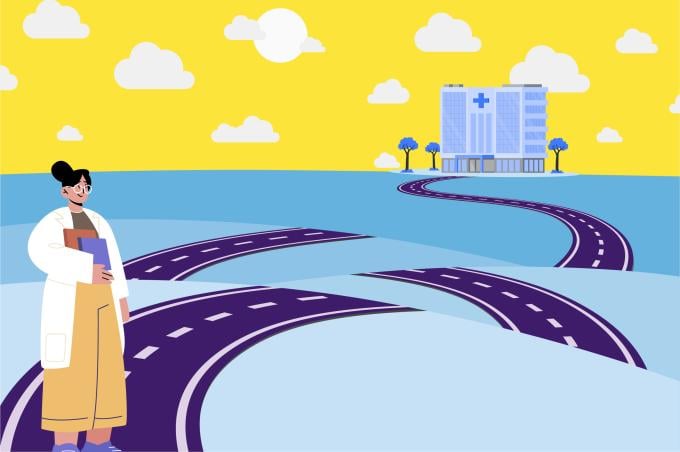When it comes to picking a medical specialty and program, medical students entering the residency Match are looking for the best fit. In some instances, that journey may require a pitstop along the way.
For help with your residency program searches, FREIDA™, the AMA Residency & Fellowship Database®, captures more than 11,000 Accreditation Council for Graduate Medical Education (ACGME)-accredited residency programs, and has a new look and feel that offers a streamlined user experience.
According to the National Resident Matching Program (NRMP), about 10 percent of trainees in the Main Residency Match will match into advanced postgraduate year 2 (PGY-2) positions and preliminary postgraduate year 1 (PGY-1) positions in tandem. Those residents will begin their training by spending a year in a more general discipline before entering their chosen specialty in year two of residency.
How does the process work? We analyzed the data and spoke with residents who have recently been through the process to find out.
Specialties requiring a preliminary year
In 2018, 11 specialties in the NRMP Main Residency Match called for a preliminary year of training before entering the specialty. In some instances, those specialties also offer categorical positions—a full-length residency training position—but those programs are typically fewer and farther between.
Eight specialties—anesthesiology, dermatology, integrated interventional radiology, neurology, physical medicine and rehab, radiation oncology and diagnostic radiology—offered 98 or more PGY-2 positions.
FREIDA includes a personalized search experience, with more than 35 filters that allow users to sort programs, including filters for preliminary, transitional and advanced residency programs.
Making the most of that preliminary year is going to depend upon which specialty you are entering.
Now a fourth-year resident in the dermatology program at the University of California, San Francisco (UCSF), Wesley Yu, MD, first did a preliminary year in internal medicine.
“The advanced programs often recommend in general that you just find a strong intern year,” he said. “Residents who go through a strong intern year are more likely to be successful, and their knowledge base is generally better.”
Dr. Yu’s colleague, Daniel Klufas, MD, entered the dermatology program at UCSF this year. He found that he benefited from doing a more general transitional year for his PGY-1 residency. Dr. Klufas did his transitional year at Memorial Sloan Kettering Cancer Center in New York City.
“A transitional year allows you to do certain rotations, like surgery, emergency medicine, outpatient clinics, and dedicated research time, that a typical preliminary medicine intern would not do,” said Dr. Klufas. “Overall, you’re left with a really well-rounded experience.”
The geography factor
It is possible to match into a preliminary PGY-1 and advanced PGY-2 program at the same institution; however, many candidates matching to both preliminary and advanced programs may be faced with the reality that they have to relocate twice in two years.
To avoid any life-altering moves on top of the extraordinary workload that many residents encounter, Dr. Yu recommended trying to factor this into your Match rankings. He ranked highly those preliminary programs that were close to the advanced institution at which he hoped to match.
For Dr. Yu, it worked out. He attended medical school at UCSF, found a preliminary position at Santa Clara Valley Medical Center, then returned to UCSF for his advanced position. Between all three positions, he moved about 50 miles total.
Matching half way
The possibility does exist that students looking to match into different programs for their PGY-1 and PGY-2 years may fail to land a spot in one or the other. If either opportunity goes unmatched, your best immediate option is the Supplemental Offer and Acceptance Program (SOAP), the vehicle through which eligible unmatched applicants in the Main Residency Match apply for and are offered positions that were not filled when the matching algorithm was initially processed.
If you match into a PGY-1 preliminary position and do not match in an advanced position, you may re-enter the NRMP Match the following year and attempt to find an advanced position. The odds of match upon re-entry, however, are not strong, and opting for a preliminary spot without an advanced position match could have serious career consequences. In 2018, for instance, 122 prior-year U.S. medical school graduate matched with PGY-2 positions, just 4 percent of the 2,650 PGY-2 spots filled.




